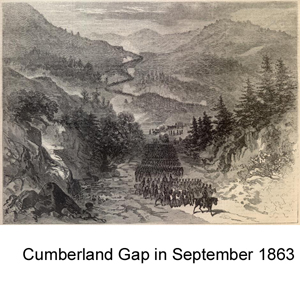Volume 37, No. 1 – January 2024
Website:
www.CivilWarRoundTablePalmBeach.org
The President’s Message:
The Round Table will not be meeting in July or August.
I look forward to seeing everyone in the fall.
If you have a program you would like to give, please call me at
561/967-8911. We are
scheduling presentations for the coming months and look forward to a
return engagement by Patrick Falci and Robert Macomber.
Gerridine LaRovere
January 10, 2024 Program:
Once again, we have Robert N. Macomber back with us again.
Although most of us are quite familiar with Robert, for our new members he is the author of the
“Honor” series of historical novels. These books, and there are 16
of them at last count, tell the story of the late 19th and early 20th
century via the fictional character of Peter Wake, USN.
familiar with Robert, for our new members he is the author of the
“Honor” series of historical novels. These books, and there are 16
of them at last count, tell the story of the late 19th and early 20th
century via the fictional character of Peter Wake, USN.
Robert has been the recipient of the Patrick D. Smith Literary Award,
the American Library Association’s W.Y. Boyd Literary Award, a Gold and
Silver Medal winner in Popular Fiction from the Florida Book Awards, and
a host of other accolades spanning over two decades. He has earned
rare experiences like being Distinguished Lecturer at NATO HQs
[Belgium], and, for ten years, was invited into the Distinguished
Military Author Series, Center for Army Analysis [Ft. Belvoir]. Robert
was named Florida Author of the Year in 2020 by the FL Writers
Association, and is a captivating storyteller helping spread a love for
history!
The Cumberland Gap During the Civil War
The Cumberland Gap is 1,304 feet in height and is a natural passage
through the Cumberland Mountains which are between Kentucky, Tennessee,
and Virginia. The Gap is
one of the natural breaks in the rugged Appalachian Mountain Range.
The Old Wilderness Road that cuts through the Cumberland Gap was a
natural invasion. For the
Confederacy, it led to the resources of Kentucky. F or the Union, it
offered an opportunity to cut the enemies supply lines.
In the summer of 1861, Confederate troops commanded by Brigadier
General Felix K. Zollicoffer secured the Gap region and began
constructing fortifications.
The fortress was a single narrow pathway that invaders had to
pass. There was plenty of
timber for campfires, barracks, and other defensive structures as well
as a grand view of the low hills and broad valleys.
By the fall, the new commander of the gap, Confederate Brigadier General
William Churchwell, directed the construction of seven forts on the
north slope and cleared the mountain of all trees within a mile.
This was the first of many scars on the beautiful landscape in
the area due to the War.
The North and South cleared and chopped the terrain.
Eventually, the mountain would be completely devoid of all tress.
On September 9, 1863, a soldier, O.G. Swingburg, from the 125th
Ohio wrote: The trees which
had formerly covered the Mountains were all cut down.
Their trunks lie tangled and scattered in all directions to
prevent rapid charges of infantry.
Surely, a valley of death could not have been more skillfully
constructed. All who walked
that road today would agree that had the charge been made, it would have
been the last road walked in eternity.
It would have been murder to have orders that assault.”
With the forts in place, trenches ringing the mountain, outposts
scattered at the foothills, and a seemingly formidable position,
Churchwell was assured of achieving victory by simply doing nothing.
Inaction can be a poor strategy even if it is the only available
one. When Zollicoffer
reached Kentucky with orders to “preserve peace. protect the railroad,
and repel invasion,” he was killed.
He mistakenly galloped into a mass of Union troops.
The many unfortunate perils of war.
Churchwell was faced with great uncertainty that Union forces would soon
be approaching the Gap. The
Northern soldiers would be assisted by the local population of
Lincolnites who were waiting for the chance to join the blue-clad
warriors.
Northern Brigadier General George W. Morgan soon arrived to take
possession of the Gap. His
plan was to lead his army through Big Creek and Roger’s Gaps which were
west of the Cumberland Gap.
They battled their way through dense woods, thick underbrush, and up
rocky terrain as they hauled cannons and wagons by block and tackle.
Morgan’s weary four columns assembled in the broad Powell Valley.
Then, the General received word that his army was to return to
the other side of the mountain they had just scaled in order to counter
an expected Confederate attack.
It is said that the bark of the surrounding trees blistered off
from the men’s profanity.
Morgan’s brief presence to the west and behind Cumberland Gap showed the
obvious to Churchwell. He
was vulnerable. That was
the problem of the Gap.
While it protected its inhabitants, it also trapped them.
The surrounding mountains made passage difficult but it did not
prevent troop movements.
Finally, Morgan was given permission by General Don Carlos Buell to turn
his troops around, cross the mountain, and go eastward up the valley.
When Federal forces arrived at the Gap on June 17, 1862, they
found the fortifications abandoned.
“The Gap is ours,” Morgan announced, “and without the loss of a
single life.”
Churchwell and his troops were needed elsewhere and the Confederates
abandoned the Gap and headed south in June of 1862.
They spiked five large cannons, destroyed supplies, and cut up
500 tents.
Morgan began building nine batteries to repel an invasion but it never
came. They were determined
to hold the Gap and supplies came down the narrow mountain roads.
A reporter from the Cincinnati Gazette wrote, “During our five
days journey we met at least 500 government wagons and not less than
3,000 mules.” Morgan
estimated that he received enough supplies for 20,000 men for ninety
days. However, he only had
half that number of men.
Pro-Union refugees came to the camp to take up arms but most of them
were in ill health and not incapable of soldiering.
By August, Confederate General Kirby Smith and his troops took a page
from Morgan’s plan book and moved through Big Creek and Roger’s Gaps.
They placed themselves directly behind Morgan.
Confederate forces operating at Barbourville, 24 miles north of
the Gap, severed Morgan’s supply line.
“If you want this fortress, come and take it.” Morgan replied to
a surrender from Smith.
Morgan’s response was heroic.
He had 10,000 troops compared to Smith’s 25,000.
On September 12, 1862 the Union quartermaster reported that
supplies were cut off.
There was no more forage for the horses and mules and the men ran out of
bread. Surrender would have
been the only option if it was not been for Captain Sidney S. Lyon.
He was a former Kentucky surveyor and knew all the minor roads
that wound through the state.
Lyon led the endangered garrison nearly two hundred miles to
safety. The Gap was in the
hands of the Confederates again without a shot being fired.
They cleared the mess Morgan and his men left behind and
strengthened the forts.
There were many skirmishes as Union soldiers from Tennessee raided the
garrison.
In September, 1863, Union forces under the command of a “tall, dapper,
lean-cheeked Irish nobleman” named John Fitzroy De Courcy.
He was ordered by General Ambrose Burnside to take the Cumberland
Gap. On September seventh,
De Courcy destroyed provisions stored at the Iron Furnace which was in
operation from 1820 to 1880 less the Civil War Years.
At the Iron Furnace limestone and iron ore were heated by coal
and converted to ‘pig iron’ which was shipped to factories.
During the Civil War years it became a place to store provisions.
Colonel De Courcy’s men numbered 1700 and were inexperienced.
They also faced a shortage of food, medicine and ammunition.
De Courcy had to convince the enemy that is small command was
much larger than it was. He
divided his men into sections and sent them marching down a hill one
section at a time, in full view of their opponents.
To the rebels the message was clear; they were about to be
attacked by a substantial force made up of infantry, cavalry, and
artillery, however, it would take more than De Courcy’s imagination to
remove the Confederates from their fortifications.
It would take some strong spirits in a bottle.
Confederate Brigadier General John W. Frazier commanded the rebel forces
at the Gap. However, with
the loss of a mill that supplied his men with corn and wheat as well as
the formidable De Courcy forces, he was not in command of his nerves.
Frazier sent Captain Rush van Leer to meet with De Courcy and
begin negotiations. Frazier
reasoned that if the armies were negotiating, they would not be shooting
at each other. A Union
officer offered van Leer a drink of whiskey and suggested that some
other Confederate officers might want a drink as well.
“Fill them to the ears, if you can.” instructed De Courcy.
Van Leer went back up the mountain ladened with whiskey.
The alcohol was dispensed to the rebel officers.
Frazier retired to his tent to think and drink.
The whiskey worked its magic and De Courcy sent a note to Frazier
that said, “It is now 12:30 PM and I shall not open fire until 2 PM
unless before that time you shall have struck all your flags and hoisted
in their stead white flags in token of surrender.”
At 3:00 PM on September ninth, Frazier surrendered the Gap.
As they lined up along Harlan Road, the Confederates were amazed
to see the small force to which they surrendered.
The Gap remained in Union hands until the end of the War.
Except for a garrison inspected by Lt. General Ulysses S. Grant
in January 1864, when he labeled the Cumberland Gap the “Gibraltar of
America.” The area remained
fairly quiet. Grant said
that “with two brigades of the Army of the Cumberland I could hold that
pass against the army which Napoleon led to Moscow.”
Although it was of strategic importance, the Cumberland Gap never
entered history as a momentous battle of the Civil War.
The Gap did change hands four times during the War.
Its isolation led to historical anonymity and eventually nature
reclaimed the land and erased any trace of the fortifications.

